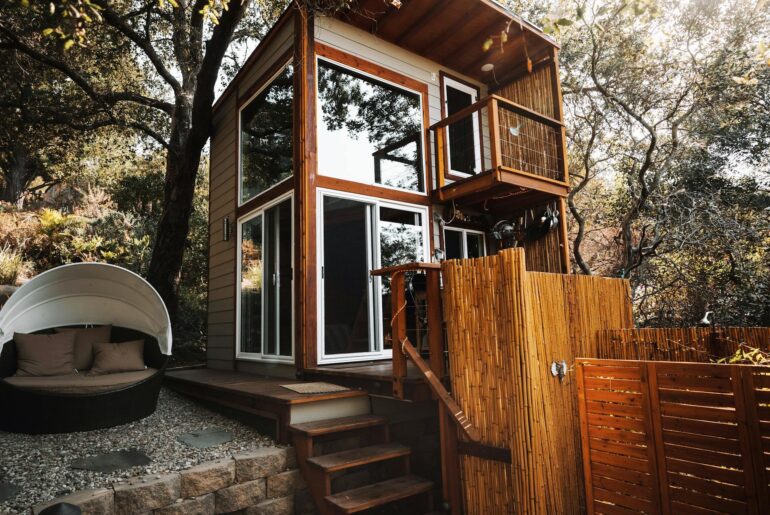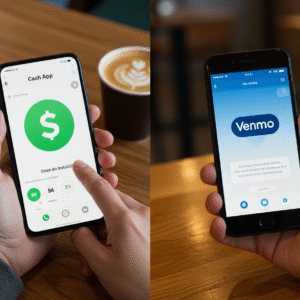This article may contain references to products or services from one or more of our advertisers or partners. We may receive compensation when you click on links to those products or services. Nonetheless, our opinions are our own.
The information presented in this article is accurate to the best of our knowledge at the time of publication. However, information is subject to change, and no guarantees are made about the continued accuracy or completeness of this content after its publication date.
Picture yourself stepping into your own tiny home, a small but cozy space that promotes a new way of living that is simple and eco-friendly. Getting the money to make this dream come true is a journey, and there are many ways to do it besides a regular savings account. There are a lot of options to think about, from personal loans to creative ways to get money. With careful planning, you can make your dream of a simple, nature-inspired life come true.
- Personal Loans: A Practical Starting Point
- Why Traditional Mortgages Don’t Fit
- Deep Dive into Financing Options
- Alternative & Niche Financing Options
- Pre-Financing Steps:
- Community-Focused Lending Institutions
- Government-Backed Loans: FHA and VA Programs
- Creative Funding Through Crowdfunding
- Additional Financing Avenues to Consider
- Budgeting for a Sustainable Future
- Conclusion
- Frequently Asked Questions
- Can I use a personal loan to finance a tiny home?
- Are there any special loans available through local banks or credit unions?
- Can FHA or VA loans be used for tiny homes?
- How does crowdfunding work for financing a tiny home?
- What is peer-to-peer lending, and how can it help?
- Can I get financing directly from a tiny home builder?
- Is it possible to use home equity to finance a tiny home?
- What expenses should I include in my tiny home budget?
- Are there zoning restrictions for tiny homes?
- What’s the best financing option for me?
- Recommended Reads
Personal Loans: A Practical Starting Point
People who need money quickly and easily often turn to personal loans as a simple solution. They can be used for a lot of different things, like buying land, paying for building materials, or paying for installation costs. These loans usually have fixed monthly payments and interest rates, which makes them a stable and predictable way to manage costs over time. If you have good credit, you may find that interest rates are better than other loans.
Take some time to look around the market before you choose a lender. Compare loan lengths, look at different offers, and think about the fees that come with each. Making a smart choice now can save you money and stress in the long run.
Why Traditional Mortgages Don’t Fit
The biggest hurdle for tiny home financing is that most tiny homes don’t qualify for conventional mortgages. Here’s why:
- Minimum Loan Amounts: Traditional lenders often have minimum loan amounts (e.g., $50,000) that exceed the cost of many tiny homes.
- Permanent Foundation Requirement: Mortgages are typically secured by real estate, which implies a permanent foundation. Many tiny homes are built on wheels or are not permanently affixed.
- Square Footage Requirements: Many lenders have minimum square footage requirements (e.g., 400-600 sq ft) that tiny homes rarely meet.
- Appraisal and Valuation: It can be difficult to appraise a tiny home’s value, as there isn’t a robust comparable market like traditional housing. Lenders rely on appraisals to determine the loan-to-value (LTV) ratio.
- Depreciation vs. Appreciation: Unlike traditional homes, which often appreciate in value, many tiny homes (especially those on wheels) are viewed more like RVs or vehicles and may depreciate over time. This makes them less attractive as collateral for a long-term mortgage.
- Zoning and Building Codes: Local regulations can be a major barrier. If your tiny home doesn’t comply with local zoning laws (e.g., minimum lot size, setback requirements, or if tiny homes are even allowed), lenders will be hesitant to finance it.
Deep Dive into Financing Options
Let’s expand on the previously mentioned options and introduce a few more:
Personal Loans:
- Ideal for: Smaller tiny homes, those who want quick funding and don’t have other collateral, or for financing a portion of a DIY build.
- Interest Rates & Terms: While rates are higher than secured loans, they can be competitive for borrowers with excellent credit (e.g., LightStream offers rates as low as 5.95% to 16.79% for tiny homes with a good credit score). Loan terms typically range from 2 to 7 years.
- DIY Builds: HELOCs are often preferred for DIY, but a personal loan can work if you have a clear budget and need a lump sum upfront.
- Down Payment: Not typically required, which can be a huge benefit.
RV Loans (Recreational Vehicle Loans):
- Key Requirement: Your tiny home must be RVIA (Recreational Vehicle Industry Association) certified. This means it meets specific standards for roadworthiness and safety, similar to a travel trailer.
- Pros: Longer terms (up to 20 years with some lenders) and potentially lower interest rates than personal loans.
- Cons: Not all tiny homes are built to RVIA standards, limiting this option. The home is collateral. Some lenders may restrict primary residency for RV loans.
- Lenders: Many major banks, credit unions, and online lenders offer RV loans.
Chattel Mortgages (Manufactured Home Loans):
- Distinctive Feature: The lender “owns” the property until the loan is fully paid off, unlike a traditional mortgage where you own the property but the lender has a lien.
- Ideal for: Tiny homes on wheels that are not RVIA certified, or those placed on leased land (e.g., in a tiny home park).
- Pros: Can be easier to secure than traditional mortgages for mobile units.
- Cons: Higher interest rates and shorter terms than traditional mortgages. Fewer consumer protections compared to traditional mortgages.
Builder/Manufacturer Financing:
- Growing Trend: As the tiny home market expands, more builders are partnering with specialized lenders or offering their own in-house financing.
- Example: Companies like MitchCraft Tiny Homes, Tiny Heirloom Tiny Homes, and Wind River Tiny Homes have partnered with KFG Financial, which offers fixed-rate mortgages between 6% and 15% with terms from 5 to 25 years. LightStream also has a dedicated “Tiny Houses” loan program.
- Benefits: Streamlined process, lenders understand tiny home nuances, potentially better rates or terms due to volume.
Home Equity Loan or HELOC:
- DIY Financing Powerhouse: HELOCs are particularly well-suited for DIY tiny home builds. You can draw funds as needed for materials and labor, only paying interest on the amount you’ve used. This avoids taking out a large lump sum loan and paying interest on money you haven’t yet spent.
- Risk: Your primary residence is on the line.
Cash (Savings):
- The “Gold Standard”: If you can, paying cash eliminates interest, loan applications, and collateral concerns. This gives you complete freedom and significantly reduces long-term costs.
Alternative & Niche Financing Options
- FHA Title I Loans: These are government-backed loans primarily for home improvements. If your tiny home is considered an Accessory Dwelling Unit (ADU) on an existing property, or if you’re building it in your backyard, you might be able to borrow up to $25,000 for construction or improvements. They offer low interest rates and terms up to 20 years.
- Credit Unions: Often more flexible and community-oriented than large banks. They may be more willing to work with unique financing situations, including tiny homes.
- Crowdfunding/Grants: Platforms like GoFundMe or specialized tiny home grants (though rare) can be explored, especially for unique or community-focused tiny home projects.
- Peer-to-Peer Lending: Platforms like LendingClub offer personal loans (as mentioned above) that can be used for tiny homes.
- Seller Financing: In some cases, if you’re buying a pre-existing tiny home directly from an individual, they might be willing to offer a payment plan. This is less common but worth exploring if the seller is open to it.
Pre-Financing Steps:
- Define Your Tiny Home Type:
- Mobile (on wheels): More likely to qualify for RV loans, personal loans, or chattel mortgages. Be aware of depreciation and the need for a towing vehicle.
- Permanent (on a foundation): Might occasionally qualify for a traditional mortgage if it meets minimum size/value requirements and local ADU regulations. Otherwise, personal loans, home equity loans, or construction loans (if building from scratch) are more likely.
- Research Local Regulations (Philippines Context): Given your location, this is paramount.
- Zoning Laws: Do local ordinances in Pavia, Western Visayas, permit tiny homes? Are there minimum size requirements for dwellings? Are ADUs allowed?
- Building Codes: What construction standards must your tiny home meet? This impacts materials, safety, and ultimately, costs.
- Permits: What permits are required for construction, electrical, plumbing, and occupancy?
- Land Use: If you don’t own land, where can you legally place your tiny home? Are tiny home communities or RV parks available for long-term living?
- Build Your Credit Score: A strong credit score (generally 660+ for favorable rates) is your most powerful tool for securing any type of loan. Pay bills on time, keep credit utilization low, and review your credit report for errors.
- Detailed Budget and Plans: Lenders will want to see a clear plan. If building, have detailed blueprints, material lists, and contractor quotes. If buying, have the manufacturer’s specs and pricing.
- Down Payment: While some loans don’t require a down payment, a larger down payment generally leads to lower interest rates and better loan terms. Aim for at least 10-20% if possible.
- Insurance: Understand that standard homeowner’s insurance typically won’t cover a tiny home on wheels. You’ll likely need specialized RV insurance. For tiny homes on foundations, it’s still best to check with insurers about specific tiny home policies.
Voted "Best Overall Budgeting App" by Forbes and WSJ
Monarch Money helps you budget, track spending, set goals, and plan your financial future—all in one app.
Get 50% OFF your first year with code MONARCHVIP
Community-Focused Lending Institutions
Credit unions and local banks bring a sense of personalization and trust that larger institutions often lack. Since credit unions operate as member-owned organizations, their lending terms can be more favorable, with lower fees and more competitive rates. Similarly, community banks prioritize relationships, working closely with individuals to craft financing solutions that reflect local market conditions.
By choosing one of these local options, you not only gain access to potentially better rates, but also a more tailored, customer-centric experience. For those who value the human touch and a connection to their community, credit unions and smaller banks can be a smart choice.
Government-Backed Loans: FHA and VA Programs
Some government-backed loans can be adapted to tiny homes, provided certain conditions are met. For instance, FHA loans often require that the home be on a permanent foundation and meet specified standards. You might be able to take advantage of more accommodating credit requirements and reduced down payments if qualified. For veterans, VA loans may be an appealing avenue, allowing qualified applicants to secure a tiny home without the need for a down payment. These programs are worth exploring if you meet the criteria and need support in financing a non-traditional living space.
Creative Funding Through Crowdfunding
A growing trend among tiny home enthusiasts is turning to crowdfunding. This approach involves sharing your vision and inviting others to support it. Platforms like Kickstarter and GoFundMe make it possible to present your project, explain your needs, and inspire contributors. The result? This results in a unique combination of funding and community engagement. Supporters can become more than donors; they may turn into advocates and partners in your journey toward tiny living.
To make a crowdfunding campaign truly effective, focus on creating an engaging story. Showcase your passion, outline the benefits of your project, and offer meaningful incentives to backers. Done well, this strategy can open up new possibilities and forge connections with like-minded individuals.
Additional Financing Avenues to Consider
For those looking beyond traditional loans or crowdfunding, other options abound. Peer-to-peer lending platforms connect borrowers directly with individual investors, often yielding competitive rates. Builders may also offer their financing packages, simplifying the process of buying a custom tiny home. Finally, if you already own a larger home, tapping into its equity might provide the funding you need at a reasonable cost.
Budgeting for a Sustainable Future
Financing a tiny home isn’t just about obtaining the money—it’s also about managing it wisely. A well-thought-out budget should account for land costs, construction materials, permits, utility connections, and ongoing expenses. Identifying potential hidden costs, such as inspections or site preparation fees, can help you avoid unpleasant surprises. By preparing a comprehensive financial plan, you set yourself up for success, ensuring that your transition to a tiny home lifestyle remains as stress-free and rewarding as possible.
Conclusion
Your tiny home dream is more than just an idea—it’s a tangible future within reach. With so many financing options available, you can choose the path that best aligns with your goals and circumstances. Whether through personal loans, local lenders, government programs, or innovative crowdfunding campaigns, the right strategy can help you turn vision into reality. By carefully weighing your choices, exploring all available resources, and planning responsibly, you’ll be well on your way to enjoying the beauty, freedom, and simplicity of tiny home living.
Frequently Asked Questions
Can I use a personal loan to finance a tiny home?
Yes. Personal loans are a common option for financing tiny homes, especially if you need flexibility and fast access to funds. They typically offer fixed interest rates and monthly payments, making it easier to plan your budget.
Are there any special loans available through local banks or credit unions?
Many credit unions and community banks offer personal or home improvement loans with competitive terms. Because they prioritize relationships and local needs, you may benefit from lower fees and more flexible lending criteria.
Can FHA or VA loans be used for tiny homes?
Yes, in some cases, a tiny home can be financed if it meets certain standards. FHA loans require the home to be built on a permanent foundation and follow HUD rules. Veterans who meet the requirements for VA loans may be able to buy a permanent home that meets lending standards.
How does crowdfunding work for financing a tiny home?
Crowdfunding involves sharing your tiny home project online through platforms like GoFundMe or Kickstarter. Supporters contribute funds, often in exchange for updates or small rewards. Success depends on storytelling, outreach, and clearly communicating your vision.
What is peer-to-peer lending, and how can it help?
Peer-to-peer (P2P) lending platforms connect borrowers with private investors online. These platforms often have flexible approval criteria and may offer lower interest rates than traditional banks.
Can I get financing directly from a tiny home builder?
Some tiny home builders offer in-house or third-party financing options. These plans may simplify the purchase process and be tailored to the cost of your specific home model.
Is it possible to use home equity to finance a tiny home?
Yes, if you own a home with sufficient equity, you can consider a home equity loan or line of credit. This can be a cost-effective way to fund your tiny home, especially if interest rates are favorable.
What expenses should I include in my tiny home budget?
Be sure to budget for:
Land acquisition or leasing
Construction or purchase costs
Permits and inspection fees
Utility hookups (water, electricity, sewage)
Transportation or site preparation
Insurance and ongoing maintenance
Are there zoning restrictions for tiny homes?
Yes. Before financing or building, check local zoning laws and building codes. Some areas have minimum square footage requirements or may limit where tiny homes on wheels can be placed.
What’s the best financing option for me?
The best option depends on your financial profile, credit history, and project goals. A personal loan may suit smaller, faster projects, while FHA, VA, or equity loans may offer longer-term, cost-effective solutions for permanent residences.

Reviewed and edited by Albert Fang.
See a typo or want to suggest an edit/revision to the content? Use the contact us form to provide feedback.
At FangWallet, we value editorial integrity and open collaboration in curating quality content for readers to enjoy. Much appreciated for the assist.
Did you like our article and find it insightful? We encourage sharing the article link with family and friends to benefit as well - better yet, sharing on social media. Thank you for the support! 🍉
Article Title: How to Finance Your Tiny Home: Personal Loans and 5 Other Options
https://fangwallet.com/2025/06/21/tiny-home-financing/The FangWallet Promise
FangWallet is an editorially independent resource - founded on breaking down challenging financial concepts for anyone to understand since 2014. While we adhere to editorial integrity, note that this post may contain references to products from our partners.
The FangWallet promise is always to have your best interest in mind and be transparent and honest about the financial picture.
Become an Insider

Subscribe to get a free daily budget planner printable to help get your money on track!
Make passive money the right way. No spam.
Editorial Disclaimer: The editorial content on this page is not provided by any of the companies mentioned. The opinions expressed here are the author's alone.
The content of this website is for informational purposes only and does not represent investment advice, or an offer or solicitation to buy or sell any security, investment, or product. Investors are encouraged to do their own due diligence, and, if necessary, consult professional advising before making any investment decisions. Investing involves a high degree of risk, and financial losses may occur including the potential loss of principal.
Source Citation References:
+ Inspo
There are no additional citations or references to note for this article at this time.












































